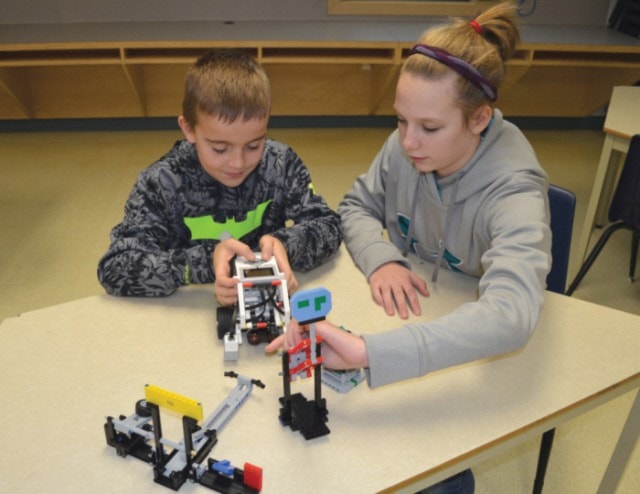École Lacombe Upper Elementary School (ELUES) has a cool new club that allows students to build functional robots with Lego pieces.
The First Lego League program runs internationally in over 50 countries, with worldwide and regional challenges.
With sponsorship from Dow Chemical Co., the school has been able to create its first club this year.
“All you’re really doing, to make it simple, is building a Lego robot that does multiple tasks like collecting rings or throwing a ball. In the club, there are different things people can do – there is programming, building and presenting. Everybody gets to pick a job they like, but we still get to do other things,” said Quinn Eberts, 11, a programmer and builder in the club.
“The teamwork makes it really fun and I’ve enjoyed all the different things you can do. It’s almost limitless to what you can do with the robot. You can design it however you want while still getting it to do the tasks.”
Quinn is one of 30 students in the First Lego League. Vice Principal Ian Wilson said that the response from the students was so overwhelming, they had to conduct an application process to narrow down the amount of kids who were able to take part for now.
Wilson said that there are quite a few benefits of the program. Students from ELUES get to work with students of Lacombe Comprehensive High School, as well as Dow workers with titles like electrical engineers. It allows the school to form community partnerships and the students to develop mentorship relationships as they work through their projects.
“Every week, we go back to the Comp and work with their robotics teacher Mr. Steven Schultz, who helps us by teaching the programming and helping the kids build the field where the robots do the tasks,” Wilson said.
“So far, the kids have built two fields and now they are in the point of building robots themselves. We have pretty well built four or five robots already. Now the task is to get the robots programmed to do the 10 tasks from opening doors to picking up balls and putting them in nets, to picking up rings and transporting them from one area to another.”
The competitions of First Lego League work with electronic mats that are constructed and programmed to facilitate 10 tasks. The tasks range from catching rings, to throwing or moving objects, among more.
Each robot is then guided with electrical programming to read actions such as backing up, turning, changes in speed and motion sequences to move around the mat and complete the designated tasks.
“One of the benefits of this program is just getting the kids connected to a team – they get to learn that teams don’t just happen as a part of sports. If they aren’t athletic or connected to the school in any other way, this could be for them.
“Something we have seen is kids getting to work together who maybe wouldn’t have before,” Wilson said.
“When you compare Lego pieces today with what they were 30 years ago, these kids are very savvy when it comes to building. They have a visual side to them, and have been building with Lego for a number of years. There are a few kids who have been to science camps and have already built robots in the past. They come in with some knowledge and background, and then get a leadership role. They can take the lead on some of these projects,”
Quinn said that the partnership with the high school students and adults from Dow was a good part of the program. He said that he enjoys being able to learn from the other people in the program and that he is considering continuing on with the First Lego League program next year.
For Quinn, a lot of the excitement of the program rests in the future.
“It’s cool to think about what you can do in the future on other robots. We’ve seen some robots that scrunch down or get really tall and that’s cool to see. In competitions, it will be nice to see what some of the other kids think of,” he said.
Unfortunately, Lacombe Upper Elementary will not be competing in the 2015 First Lego League challenges. Wilson said this is simply due to them getting a bit of a later start on the program than other schools. He said that next year the school would take part in competitions.
He added that he is excited for some of the students at ELUES to move up in their grades and have a program to look forward too, and that the continuation of the projects is exciting for the kids.
“This year, there is a teacher at the junior high who is running an option course for First Lego League.
“These kids will be able to go to the junior high and continue on, then move into the high school robotics. That is a longterm benefit of the program. It might end up being a nine-year program for some kids in Lacombe,” he said.
“These competitions are international, so when the kids see that what they do here on a smaller scale will eventually be amazing, that is phenomenal for them. They will get to build their own robots and eventually compete against other schools and other countries.
“We did limit it to Grades five and six because of the numbers. We think it’s a great addition to our school. When we look at the long-term benefits, and where it could take us as a school, it’s very exciting.”
